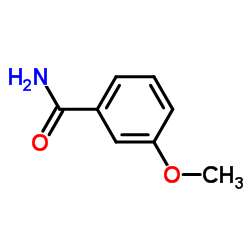3-Methoxybenzamide

3-Methoxybenzamide structure
|
Common Name | 3-Methoxybenzamide | ||
|---|---|---|---|---|
| CAS Number | 5813-86-5 | Molecular Weight | 151.163 | |
| Density | 1.1±0.1 g/cm3 | Boiling Point | 280.0±23.0 °C at 760 mmHg | |
| Molecular Formula | C8H9NO2 | Melting Point | 132.5-135.5 °C(lit.) | |
| MSDS | Chinese USA | Flash Point | 146.8±18.9 °C | |
|
Characterization of the superinduction of the c-myc proto-oncogene in fibroblasts by benzamide derivatives.
Mol. Cell Biochem. 124(2) , 175-81, (1993) In mouse fibroblasts stimulated from quiescence into proliferation by serum the induction of expression of the c-myc proto-oncogene is strongly stimulated by 3-methoxybenzamide. Similar superinduction effects are seen with related compounds such as 3-aminoben... |
|
|
Immunosuppressive activities of 6(5H)-phenanthridinone, a new poly(ADP-ribose)polymerase inhibitor.
Int. J. Immunopharmacol. 17(4) , 265-71, (1995) 6(5H)-phenanthridinone, a recently identified poly(ADP-ribose)polymerase (PARP) inhibitor, is able, at micromolar concentrations, to inhibit concanavalin A-induced lymphocyte proliferation and to potentiate the effect of gamma radiation upon murine spleen cel... |
|
|
Antibacterial alkoxybenzamide inhibitors of the essential bacterial cell division protein FtsZ.
Bioorg. Med. Chem. Lett. 19 , 524-7, (2009) 3-Methoxybenzamide is a weak inhibitor of the essential bacterial cell division protein FtsZ. Exploration of the structure-activity relationships of 3-methoxybenzamide analogues led to the identification of potent anti-staphylococcal compounds. |
|
|
Stimulation of intrachromosomal homologous recombination in mammalian cells by an inhibitor of poly(ADP-ribosylation).
Nucleic Acids Res. 19(21) , 5943-7, (1991) We determined the effect of 3-methoxybenzamide (3-MB), a competitive inhibitor of poly(ADP-ribose) polymerase (E.C. 2.4.2.30), on intrachromosomal homologous recombination in mouse Ltk- cells. We used a cell line that contained in its genome two defective Her... |
|
|
Hormone levels and tumour size response to quinagolide and cabergoline in patients with prolactin-secreting and clinically non-functioning pituitary adenomas: predictive value of pituitary scintigraphy with 123I-methoxybenzamide.
Clin. Endocrinol. (Oxf.) 52(4) , 437-45, (2000) Dopamine agonists are indicated as primary therapy for PRL-secreting pituitary adenomas, while controversial results have been reported in nonfunctioning adenomas (NFA).To evaluate whether the in vivo visualization of dopamine D2 receptor expression detected ... |
|
|
Inhibitors of poly (ADP-ribose) polymerase suppress lipopolysaccharide-induced nitrite formation in macrophages.
Biochem. Biophys. Res. Commun. 179(2) , 865-71, (1991) Stimulating bone marrow derived macrophages with LPS results in the induction of NO-synthase as measured by NO2- formation. Inhibitors of poly(ADP-ribose)polymerase, namely nicotinamide, 3-aminobenzamide and 3-methoxybenzamide, prevented NO2- formation in a d... |
|
|
The immunosuppressive substance 2-chloro-2-deoxyadenosine modulates lipoprotein metabolism in a murine macrophage cell line (P388 cells).
Lipids 29(9) , 627-33, (1994) A recently developed immunosuppressive substance, 2-chloro-2-deoxyadenosine (2-CdA), was reported to inhibit monocyte functions at low concentration. Because macrophages play a key role in the formation of atherosclerotic plaques, it was of interest to study ... |
|
|
Regulation of mouse P(1)450 gene expression in monolayer-cultured hepatocytes from responsive and non-responsive strains.
Carcinogenesis 12(4) , 623-9, (1991) Regulation of P(1)450 gene expression in mouse hepatocytes from responsive (C57BL/6) and non-responsive (DBA/2) strains in primary culture was investigated with respect to aryl hydrocarbon hydroxylase (AHH) activity and P450 transcript levels. Although signif... |
|
|
ADP-ribosylation of proteins in Bacillus subtilis and its possible importance in sporulation.
J. Bacteriol. 178(16) , 4935-41, (1996) Endogenous ADP-ribosylation was detected in Bacillus subtilis, as determined in vitro with crude cellular extracts. The ADP-ribosylated protein profile changed during growth in sporulation medium, displaying a temporary appearance of two ADP-ribosylated prote... |
|
|
Differentiation and limited proliferation of isolated Leishmania mexicana amastigotes at 27 degrees C.
Acta Trop. 50(2) , 141-50, (1991) We have demonstrated here that while many amastigotes of both Leishmania mexicana amazonensis and Leishmania mexicana mexicana differentiate to promastigotes when placed in culture at 27 degrees C, many others remain as amastigotes in their proliferative cycl... |